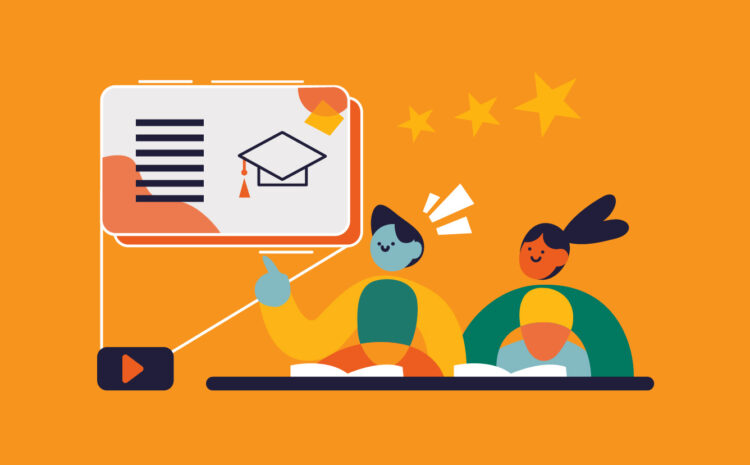The Role of Animation in Educational Videos: Enhancing Learning
In today’s digital age, educational videos have emerged as a powerful tool for imparting knowledge and engaging learners of all ages. In this blog, we will explore the pivotal role of animation in educational videos, highlighting its benefits, applications, and how it enhances the learning experience. One key element that has revolutionized the way educational content is presented is animation. Animation brings concepts to life, making complex topics more accessible and enjoyable.

Understanding the Importance of Animation in Educational Videos:
Enhancing Engagement: Animation captures attention and sustains interest, especially among younger learners who are more visually oriented. By incorporating engaging visuals, colors, and characters, educational videos with animation effectively capture and maintain students’ attention, fostering a positive learning experience.
Simplifying Complex Concepts: Animation allows educators to break down complex concepts into digestible parts. By using visual metaphors, diagrams, and illustrations, abstract or intricate ideas can be simplified, making them more comprehensible to learners. Animated videos can visualize concepts that are difficult to capture through traditional teaching methods, facilitating better understanding and retention.
Stimulating Imagination and Creativity: Animations have a unique ability to transport learners into imaginative worlds, stimulating their creativity and critical thinking. By presenting information in a visually appealing and entertaining manner, educational videos with animation encourage students to think outside the box, fostering a sense of curiosity and exploration.
Catering to Different Learning Styles: Every student has a unique learning style, and animation accommodates various preferences. Visual learners benefit greatly from the rich visuals and illustrations, while auditory learners can absorb information through voiceovers and sound effects. Kinesthetic learners can engage with interactive animations that allow them to interact with the content, reinforcing their understanding.
Applications of Animation in Educational Videos:
Science and Technology Education: Animation is instrumental in explaining scientific phenomena, processes, and principles that are challenging to visualize. For example, complex cellular processes, astronomical events, and the functioning of machines can be effectively demonstrated through animation, providing a clearer understanding for students.
Language Learning: Animation can play a vital role in language education, aiding in vocabulary acquisition, grammar comprehension, and cultural understanding. Through animated stories, dialogues, and scenarios, students can immerse themselves in the language and improve their listening and speaking skills.
History and Social Sciences: Animated videos can transport students back in time, making historical events more relatable and engaging. By recreating historical moments, figures, and cultures, animation brings history to life, creating a memorable learning experience.
Mathematics and Logic: Animation can help students grasp abstract mathematical concepts, such as geometry, algebra, and calculus. By visually representing mathematical operations and relationships, animated videos provide a concrete foundation for understanding these principles.
The Impact of Animation on Learning Outcomes:
Increased Retention: Visual storytelling through animation activates both visual and auditory senses, resulting in higher retention rates. Studies have shown that learners retain more information when it is presented in an engaging and interactive manner, making animation a valuable tool for enhancing memory recall.
Improved Conceptual Understanding: Animations allow students to visualize and interact with concepts, enabling a deeper understanding of the subject matter. By presenting information from different perspectives, animation facilitates connections between ideas and promotes a holistic understanding of complex topics.
Enhanced Motivation and Enthusiasm: The dynamic and immersive nature of animated educational videos can foster a positive learning environment. Students are more likely to be motivated and enthusiastic about learning when they are engaged with captivating visuals and interactive content.
Accessibility and Inclusivity: Animation transcends language barriers, making educational content more accessible to learners from diverse backgrounds. Additionally, animation can accommodate students with special needs by incorporating features like closed captions, visual cues, and interactive elements, ensuring an inclusive learning experience.
FAQ
How can I get my own animated educational videos?
Creating animated educational videos requires a combination of creativity, storytelling skills, and technical know-how. You can start by brainstorming your content, creating a script, and storyboarding your ideas or You can contact us (DUTTA INNOVATIONS), Our expert will assist you step-wise step.
What is animation in educational videos?
Animation in educational videos refers to the use of visual elements, such as moving images, characters, and illustrations, to present information, concepts, and ideas in an engaging and interactive manner. It involves the creation of animated sequences that bring static content to life, making it more accessible and understandable for learners.
How does animation enhance learning in educational videos?
Animation enhances learning in educational videos by capturing and sustaining learners’ attention through engaging visuals and characters. It simplifies complex concepts by breaking them down into easily digestible parts, making them more comprehensible. Animation stimulates imagination and creativity, encourages critical thinking, and accommodates different learning styles, leading to improved retention and understanding.
What subjects benefit from animation in educational videos?
Animation can benefit a wide range of subjects in educational videos. It is particularly useful in science and technology education, where abstract concepts and processes can be visualized. Animation is also valuable in language learning, history, social sciences, and mathematics, as it makes these subjects more relatable, interactive, and engaging for students.
How does animation impact learning outcomes?
Animation positively impacts learning outcomes in several ways. It increases retention rates by activating multiple senses, improves conceptual understanding by visualizing complex ideas, and enhances motivation and enthusiasm for learning. Animation also promotes inclusivity by making educational content accessible to diverse learners and accommodating students with special needs.
Can animation be used in online learning platforms?
Absolutely! Animation is highly suitable for online learning platforms. It can be seamlessly integrated into e-learning modules, video lectures, interactive presentations, and online courses. Animation enhances the visual appeal and interactivity of online learning materials, making them more engaging and effective for distance learners. DUTTA INNOVATIONS offers animation services tailored for online learning platforms, ensuring captivating and impactful educational content.
Summary:
Animation has revolutionized educational videos by making learning more engaging, accessible, and effective. Through its ability to simplify complex concepts, stimulate imagination, and cater to different learning styles, animation has become an invaluable tool in the educational landscape. By harnessing the power of animation, educators can create captivating learning experiences that inspire and empower students, paving the way for a brighter future of education.



Write a Comment